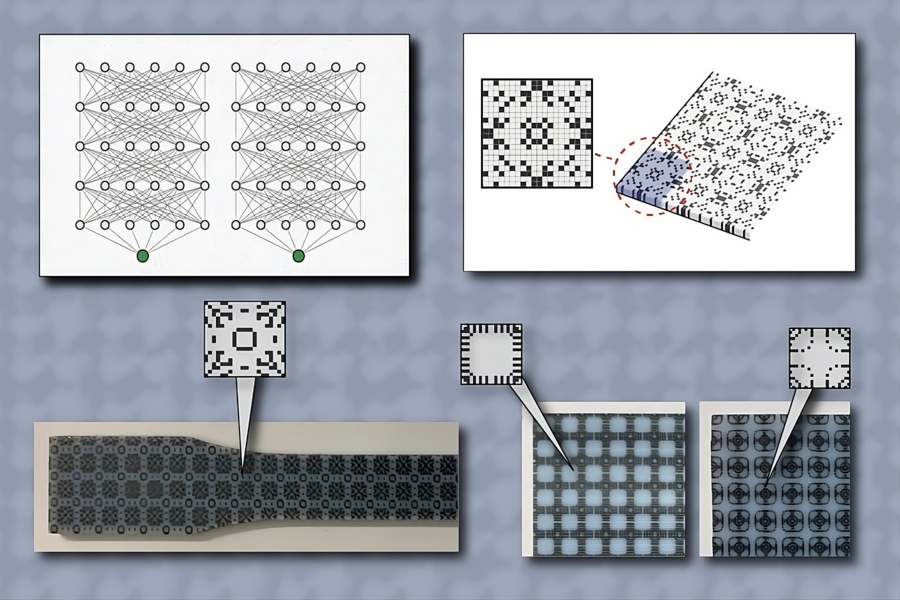
ΑΙhub.org
Using machine learning to discover stiff and tough microstructures
 A new computational pipeline developed over three years efficiently identifies stiff and tough microstructures suitable for 3D printing in a wide range of engineering applications. The approach greatly reduces the development time for high-performance microstructure composites and requires minimal materials science expertise.
A new computational pipeline developed over three years efficiently identifies stiff and tough microstructures suitable for 3D printing in a wide range of engineering applications. The approach greatly reduces the development time for high-performance microstructure composites and requires minimal materials science expertise.
Image credit: Alex Shipps/MIT CSAIL.
By Rachel Gordon
Every time you smoothly drive from point A to point B, you’re not just enjoying the convenience of your car, but also the sophisticated engineering that makes it safe and reliable. Beyond its comfort and protective features lies a lesser-known yet crucial aspect: the expertly optimized mechanical performance of microstructured materials. These materials, integral yet often unacknowledged, are what fortify your vehicle, ensuring durability and strength on every journey.
Luckily, MIT Computer Science and Artificial Intelligence Laboratory (CSAIL) scientists have thought about this for you. A team of researchers moved beyond traditional trial-and-error methods to create materials with extraordinary performance through computational design. Their new system integrates physical experiments, physics-based simulations, and neural networks to navigate the discrepancies often found between theoretical models and practical results. One of the most striking outcomes: the discovery of microstructured composites — used in everything from cars to airplanes — that are much tougher and durable, with an optimal balance of stiffness and toughness.
“Composite design and fabrication is fundamental to engineering. The implications of our work will hopefully extend far beyond the realm of solid mechanics. Our methodology provides a blueprint for a computational design that can be adapted to diverse fields such as polymer chemistry, fluid dynamics, meteorology, and even robotics,” says Beichen Li, an MIT PhD student in electrical engineering and computer science, CSAIL affiliate, and lead researcher on the project.
An open-access paper on the work was published in Science Advances last month.
In the vibrant world of materials science, atoms and molecules are like tiny architects, constantly collaborating to build the future of everything. Still, each element must find its perfect partner, and in this case, the focus was on finding a balance between two critical properties of materials: stiffness and toughness. Their method involved a large design space of two types of base materials — one hard and brittle, the other soft and ductile — to explore various spatial arrangements to discover optimal microstructures.
A key innovation in their approach was the use of neural networks as surrogate models for the simulations, reducing the time and resources needed for material design. “This evolutionary algorithm, accelerated by neural networks, guides our exploration, allowing us to find the best-performing samples efficiently,” says Li.
Magical microstructures
The research team started their process by crafting 3D printed photopolymers, roughly the size of a smartphone but slimmer, and adding a small notch and a triangular cut to each. After a specialized ultraviolet light treatment, the samples were evaluated using a standard testing machine — the Instron 5984 — for tensile testing to gauge strength and flexibility.
Simultaneously, the study melded physical trials with sophisticated simulations. Using a high-performance computing framework, the team could predict and refine the material characteristics before even creating them. The biggest feat, they said, was in the nuanced technique of binding different materials at a microscopic scale — a method involving an intricate pattern of minuscule droplets that fused rigid and pliant substances, striking the right balance between strength and flexibility. The simulations closely matched physical testing results, validating the overall effectiveness.
Rounding the system out was their “Neural-Network Accelerated Multi-Objective Optimization” (NMO) algorithm, for navigating the complex design landscape of microstructures, unveiling configurations that exhibited near-optimal mechanical attributes. The workflow operates like a self-correcting mechanism, continually refining predictions to align closer with reality.
However, the journey hasn’t been without challenges. Li highlights the difficulties in maintaining consistency in 3D printing and integrating neural network predictions, simulations, and real-world experiments into an efficient pipeline.
As for the next steps, the team is focused on making the process more usable and scalable. Li foresees a future where labs are fully automated, minimizing human supervision and maximizing efficiency. “Our goal is to see everything, from fabrication to testing and computation, automated in an integrated lab setup,” Li concludes.
The research article
Computational discovery of microstructured composites with optimal stiffness-toughness trade-offs, Beichen Li, Bolei Deng, Wan Shou, Tae- Hyun Oh, Yuanming Hu, Yiyue Luo, Liang Shi, Wojciech Matusik.








